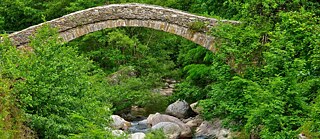Laws of Nature
Mistakes Mean Creation
Thanks to the natural sciences, we believe the world should be orderly, harmonious, efficient – and flawless. But nature and the universe are all about random variation and inconsistencies.
A spring high up in the Ligurian Apennines, on the side of the Italian mountain range facing the Mediterranean Sea. Slabs of slate, just a few centimeters apart, protrude from the slope under the shade of oaks and chestnut trees. Water seeps through the crevices between the slabs and collects in a stony hollow beneath hazel and alder shrubs.
Last year’s withered leaves lie in the shallow basin amid fragments of slate and granite pebbles washed smooth by the water as it gushes quietly over the edge of a rock and circumvents a mossy block. Its path is impeded by fallen trunks, so it takes a detour around another protruding rock.
Naturally, gravity is no exception to the rule. Water always flows downhill. But it runs into impediments along the way. In the laboratory, physicists have to eliminate all the impediments that cause detours and circuitous routes in order to formulate their equations. To measure gravity correctly, they have to build a vacuum tower. Otherwise, errors are bound to creep in. And reality is apparently based on this very principle: that the laws of nature are often steeped in the greatest disarray – and that it is precisely these deviations from straight lines and uniformity that give shape to the cosmos.
In our everyday understanding of the world, we often presume the opposite to be true. Over the centuries, scientists have led us to believe that nature is the epitome of order, efficiency, and flawlessness. That nature, reality itself, is the epitome of harmony (which we humans are constantly disturbing and increasingly destroying through our ham-handed tampering). If you look at the universe in action, however, it often seems to be messing around with the loopholes in its own laws and to be less harmonious than curious, open to inconsistencies and imbalances – just like human beings.
Hydrogen, in contrast, helium’s next-door neighbor on the periodic table, is constantly decomposing into its component parts. It loses its electron to become a reactive element in acids and partners with oxygen to form the stuff of life: water. Naturally, the laws of chemistry apply to H2, too. But hydrogen pulls all the stops, drawing on the whole gamut of natural laws to cause trouble and undermine every attempt at flawless uniformity.
The physical chemist Ilya Prigogine and philosopher of science Isabelle Stengers see unexpected deviations as the very key to the self-organization of the universe. Nature is not an order that defies chaos, but an order that exists because chaos has a finger in every pie. It’s like the famous butterfly effect: in a complex system, a single variation can result in everything developing in a different direction at a later state. The flow of air caused by the proverbial flapping of a butterfly’s wings, for example, could ultimately set off a tropical cyclone through feedback and self-reinforcement.
It’s amazing how much Lucretius anticipated modern physics. Today, we know that atoms and molecules merely seem stable. They remain at rest until, at some point, they unexpectedly disintegrate. These quantum fluctuations turn matter into something fluid. They’re most pronounced in the natural process of radioactive decay. The half-life of a radioactive element is defined as the time it takes for half of a certain amount of said element to “decay” and be transformed into another element. There is no telling whether a particular atom will decay at the beginning or the end of that period – if at all. Thus, quantum physics introduces error into the inner workings of the laws of nature.
Biology without errors would be fatal. Because the environment is constantly changing (due to deviations from the norm), perfectly reproduced animal and plant species would inevitably be wiped out, e.g. by a warming or cooling earth. So error is essential for individuality to emerge. And we may learn an important lesson from nature: errors make creation possible in the first place.
The French writer and aviator Antoine de Saint-Exupéry, who disappeared on a reconnaissance mission over the Mediterranean in 1944, put it this way in one of his novels:
“I am the error in the calculation: I am life.”
Last year’s withered leaves lie in the shallow basin amid fragments of slate and granite pebbles washed smooth by the water as it gushes quietly over the edge of a rock and circumvents a mossy block. Its path is impeded by fallen trunks, so it takes a detour around another protruding rock.
Obstacles everywhere
The water flows downwards into the valley, but never in a straight line. There’s always something in the way: a fold in the landscape, deadwood, slabs of slate, a marshy meadow. The direction of the headstream’s flow obeys the law of gravity. And yet, its course is the upshot of errors of execution, for there are obstacles everywhere. It might even be said that what we call a landscape is based on the face that straight lines don’t work in nature. The shape of the world results as much from the laws of nature as from deviations, which constantly necessitates new interpretations.Naturally, gravity is no exception to the rule. Water always flows downhill. But it runs into impediments along the way. In the laboratory, physicists have to eliminate all the impediments that cause detours and circuitous routes in order to formulate their equations. To measure gravity correctly, they have to build a vacuum tower. Otherwise, errors are bound to creep in. And reality is apparently based on this very principle: that the laws of nature are often steeped in the greatest disarray – and that it is precisely these deviations from straight lines and uniformity that give shape to the cosmos.
In our everyday understanding of the world, we often presume the opposite to be true. Over the centuries, scientists have led us to believe that nature is the epitome of order, efficiency, and flawlessness. That nature, reality itself, is the epitome of harmony (which we humans are constantly disturbing and increasingly destroying through our ham-handed tampering). If you look at the universe in action, however, it often seems to be messing around with the loopholes in its own laws and to be less harmonious than curious, open to inconsistencies and imbalances – just like human beings.
An element that uses the whole gamut of nature’s laws to cause trouble
Consider the atom. The electrons in an atom circle in various orbitals around a nucleus. The more flawless the atom, the less it actually does. Take the noble gas helium, for example. Its electrons are evenly distributed in the atom, it appears to exist in a state of perfect, all but imperturbable, physical harmony. As a result, it’s hardly reactive at all. Moreover, helium has no odor or color, and is neither combustible nor toxic. Like the other noble gases (such as neon, argon, and xenon), it doesn’t bond with any other elements. It’s like a chaste Pietist who never lapses… and has become a bore as a result.Hydrogen, in contrast, helium’s next-door neighbor on the periodic table, is constantly decomposing into its component parts. It loses its electron to become a reactive element in acids and partners with oxygen to form the stuff of life: water. Naturally, the laws of chemistry apply to H2, too. But hydrogen pulls all the stops, drawing on the whole gamut of natural laws to cause trouble and undermine every attempt at flawless uniformity.
The physical chemist Ilya Prigogine and philosopher of science Isabelle Stengers see unexpected deviations as the very key to the self-organization of the universe. Nature is not an order that defies chaos, but an order that exists because chaos has a finger in every pie. It’s like the famous butterfly effect: in a complex system, a single variation can result in everything developing in a different direction at a later state. The flow of air caused by the proverbial flapping of a butterfly’s wings, for example, could ultimately set off a tropical cyclone through feedback and self-reinforcement.
Swerve
Prigogine and Stengers refer to a key text in Western culture: On the Nature of Things (De Rerum Natura), a didactic poem from the first century BC by Lucretius, which was rediscovered in 1417. The Roman poet and philosopher describes the universe as pure matter. Atoms move along straight paths through empty space, solitary and without touching – were it not for the clinamen, a Latin term to mean a tiny, unpredictable deviation, or “swerve,” from straight-line motion. For Lucretius, the clinamen causes errors to creep into the uniformity of pure matter. These lead to collisions between the discrete particles, to attractions, and connections, which in turn, yield the forms of the world.It’s amazing how much Lucretius anticipated modern physics. Today, we know that atoms and molecules merely seem stable. They remain at rest until, at some point, they unexpectedly disintegrate. These quantum fluctuations turn matter into something fluid. They’re most pronounced in the natural process of radioactive decay. The half-life of a radioactive element is defined as the time it takes for half of a certain amount of said element to “decay” and be transformed into another element. There is no telling whether a particular atom will decay at the beginning or the end of that period – if at all. Thus, quantum physics introduces error into the inner workings of the laws of nature.
Biology without errors would be fatal
Lucretius’s idea is even more astonishing from a biological perspective from which random variation is the driving force of life. Evolution can only occur if and when a mutation – an error in a copy of a gene – yields a new physical trait. Genetic errors are often fatal for organisms, even in the embryonic stage. Sometimes, however, mutations produce a beneficial trait: longer wings, brighter colors, a penchant for writing poetry. They serve to add a new life form to the “endless forms most beautiful and most wonderful,” as Darwin called the kingdom of life.Biology without errors would be fatal. Because the environment is constantly changing (due to deviations from the norm), perfectly reproduced animal and plant species would inevitably be wiped out, e.g. by a warming or cooling earth. So error is essential for individuality to emerge. And we may learn an important lesson from nature: errors make creation possible in the first place.
The French writer and aviator Antoine de Saint-Exupéry, who disappeared on a reconnaissance mission over the Mediterranean in 1944, put it this way in one of his novels:
“I am the error in the calculation: I am life.”


